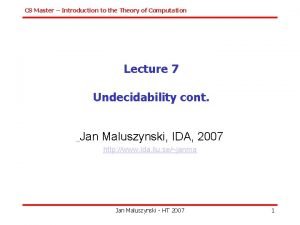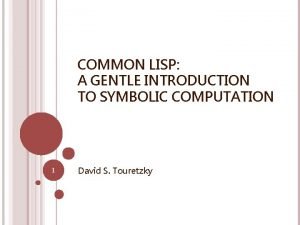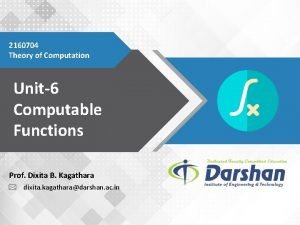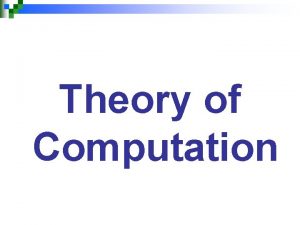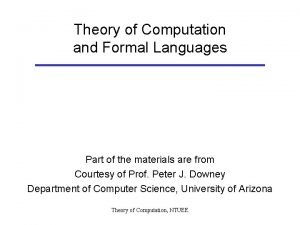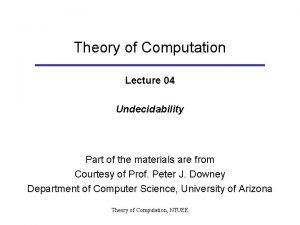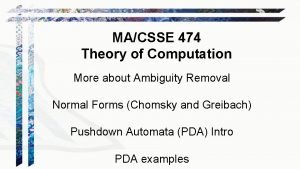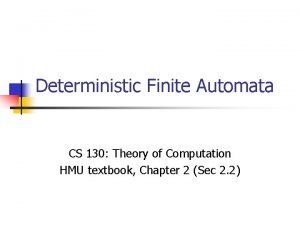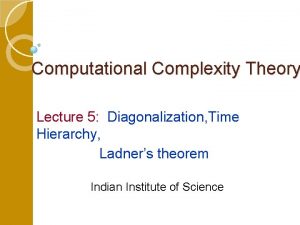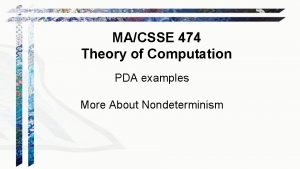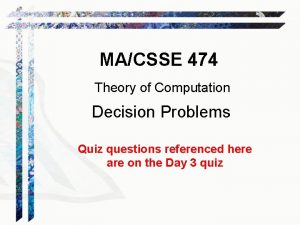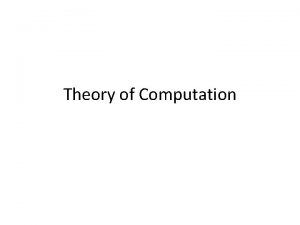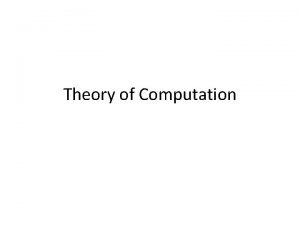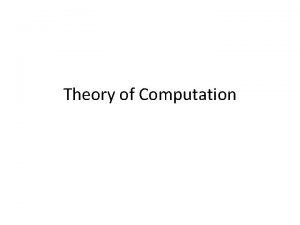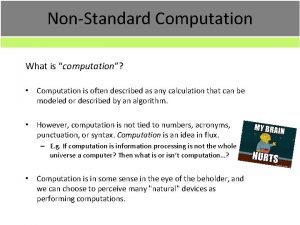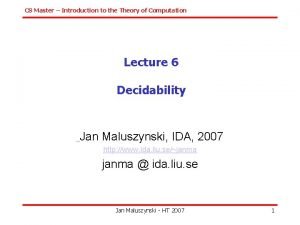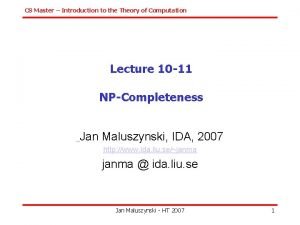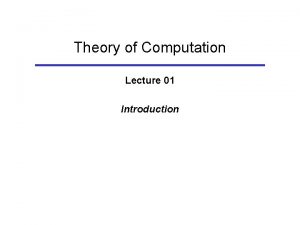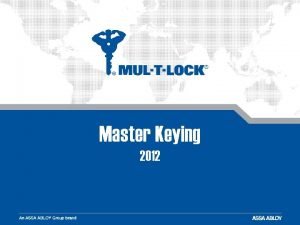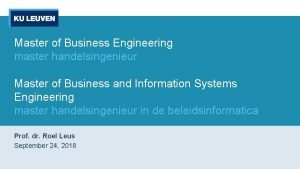CS Master Introduction to the Theory of Computation











- Slides: 11

CS Master – Introduction to the Theory of Computation Lecture 7 Undecidability cont. Jan Maluszynski, IDA, 2007 http: //www. ida. liu. se/~janma Jan Maluszynski - HT 2007 1

CS Master – Introduction to the Theory of Computation Outline (Sipser 5. 1, 5. 3, 6. 2) 1. 2. 3. 4. Reducibility Examples of undecidable problems Mapping reducibility Decidability of Logical Theories Jan Maluszynski - HT 2007 2

CS Master – Introduction to the Theory of Computation Reduction techniques For proving B is undecidable • Assume B is decidable • Find an undecidable problem A that can be decided using the decision procedure for B A reducible to B Example: HALTTM = {<M, w>| M is a TM and M halts on w} We show: ATM = {<M, w>| M is a TM and M accepts w} is reducible to HALTTM Jan Maluszynski - HT 2007 3

CS Master – Introduction to the Theory of Computation Reduction techniques example Assume TM R decides HALTTM = On input <M, w> run R on it: • If R rejects – reject • If R accepts ie. M halts on w: simulate M on w – If M accepts w – accept – If M rejects w - reject Thus with R we could decide ATM = {<M, w>| M is a TM and M accepts w} But we know ATM is undecidable Hence R cannot exist and HALTTM is undecidable Jan Maluszynski - HT 2007 4

CS Master – Introduction to the Theory of Computation ETM (emptiness) is undecidable ETM = {<M>| M is a TM and L(M) is empty} Assume R decides ETM. Reduce ATM to ETM. Given M and w construct M 1 that on any input x : • If x = w simulates M on w • Otherwise rejects x. Run R on <M 1>: M 1 is rejected iff M accepts w. Thus with R we could decide ATM = {<M, w>| M is a TM and M accepts w} But we know ATM is undecidable Hence R cannot exist and ETM is undecidable Jan Maluszynski - HT 2007 5

CS Master – Introduction to the Theory of Computation Rice’s theorem Let P be any nontrivial property of the language of a Turing machine M. Nontrivial: it contains some but not all TM descriptions. Theorem: {<M>| L(M) satisfies P} is undecidable e. g given M it is undecidable if L(M) is: - empty, - regular, - Context-free …. Jan Maluszynski - HT 2007 6

CS Master – Introduction to the Theory of Computation Mapping reducibility A function f: * * is computable if some TM M on every input w halts with f(w) on its tape Language A is mapping reducible to B written A m. B if there is a computable function f s. that for every w w A f(w) B f is called reduction of A to B. Jan Maluszynski - HT 2007 7

CS Master – Introduction to the Theory of Computation Mapping reducibility cont. Theorem: If A m. B and A is undecidable then B is undecidable Example: f(<M>) = <M, M 1> where M 1 rejects all inputs reduces emptiness problem to TM equivalence Jan Maluszynski - HT 2007 8

CS Master – Introduction to the Theory of Computation Mapping reducibility cont. Theorem: If A m. B and A is not Turing-recognizable then B is not Turing-recognizable Remark: A m. B iff complement(A) m complement(B) To prove B not Turing-recognizable show: A mcomplement(B) for some undecidable A Jan Maluszynski - HT 2007 9

CS Master – Introduction to the Theory of Computation TM equivalence is not T-recognizable Reduce ATM to (negation) EQTM For given <M, w> construct TMs: (M 1 rejects all inputs) M 3 accepts all inputs M 2: On any input simulates M on w accepts if M accepts w 1. <M 1, M 2> equivalent iff M does not accept w 2. <M 3, M 2> equivalent iff M accepts w Hence: by (1) EQTM not Turing-recognizable by (2) complement of EQTM not Turing-recognizable Jan Maluszynski - HT 2007 10

CS Master – Introduction to the Theory of Computation More examples of undecidable languages Hilbert’s tenth problem: Does a given polynomial with integer coefficients has an integral root? Stated early 1900 proved undecidable 1970 The language Th(N, +, ) of true closed arithmetic formulae interpreted on natural numbers e. g. x y z[x=y+z] Jan Maluszynski - HT 2007 11
 Sipser, m: introduction to the theory of computation
Sipser, m: introduction to the theory of computation Introduction to the theory of computation
Introduction to the theory of computation Common lisp: a gentle introduction to symbolic computation
Common lisp: a gentle introduction to symbolic computation 2160704
2160704 Transition graph examples
Transition graph examples Types of languages in theory of computation
Types of languages in theory of computation Theory of computation
Theory of computation Theory of computation
Theory of computation Finite automata calculator
Finite automata calculator Diagonalization method in theory of computation
Diagonalization method in theory of computation Pda theory of computation
Pda theory of computation Theory of computation quiz
Theory of computation quiz

